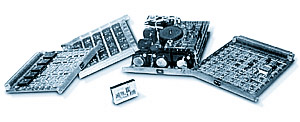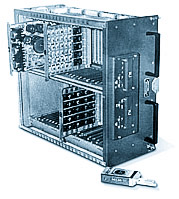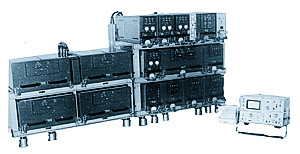A-30 Computer
Home → Articles → A-30 Computer
Vitaly Iosifovich Shteinberg

A-30 cells
- A-30 is a general purpose mobile computer.
- The development team chiefs: V. M. Karasik, V. I. Shteinberg. The development team: M. M. Agureyeva, V. I. Alekseyev, V. S. Vorobyov, V. A. Grinkevich, M. F. Kats, A. K. Keilin, Yu. Kh. Kleiman, Yu. R. Lemzal, P. I. Osokin, S. O. Popov, A. Ya. Tyurin, V. S. Shokhat.
- Development organization: Research Center of Computer Engineering (NICEVT) of the USSR Ministry of Radio Engineering (since 1986 - Research Institute Argon).
- Manufacturers: Moscow Plant of Calculating and Analyzing Machines (SAM), Brest Electromechanical Plant.
- Development was completed in 1977.
- Commercial production began in 1979.
- A-30 is still in production.
- Applications: computer control systems for defense applications.

A-30 cell unit
- System architecture: A-30 was the first model of a high-performance unified 32-bit mobile computer set based on the ES EVM architecture, to be designed for processing and storing large volumes of data. This computer was ES EMV compatible in its architecture, structure, circuitry and technology and was adapted to specialized mobile system requirements, primarily in physical size and in providing the highest possible performance. A-30 was backward compatible with ES EVM - 1 both by data and programs. It was controlled by firmware. This computer uses modules and standard units, that's why it is possible to upgrade its computational capabilities easy. The I/O subsystem includes two multiplex channels (specialized and ES EVM), providing high-speed data exchange with subscribers in real time. It is possible to use this computer in multiprocessor systems connected through channel-to-channel adapters.
Instruction set is the standard ES EVM-1 set excluding decimal arithmetical and floating point instructions.
Data types are byte, 16-bit word, 32-bit double word.
Instruction word lengths are 16 and 32 bits.
Addressing - by byte.
Addressable memory capacity - 64K words.
Interblock data exchange method - backbone through two buses.
Speed - 400,000 RX format instructions per second; 600,000 RR format instructions per second.
RAM - PBM/0,8-2 magnetic core matrices; capacity - 32 Kbytes.
ROM - U-shaped ferrite cores; capacity - 256 Kbytes.
EPROM - digital ferrite lines; capacity - 1 Kbyte.
SMK special multiplex channel:
Data buses word size - 2 bytes.
Communication system - semi-synchronous.
Throughput - 200 Kbps in multiplex mode; 500 Kbps in burst mode.
ES EVM multiplex channel - fully compatible with ES EMV software and standard I/O interface.
Subchannels number - 127.
Throughput - 30 Kbps in a multiplex mode; 250 Kbps in a burst mode.
Intercomputer exchange:
Channel-to-channel adapters number - 4
It is possible to build four- and two- computer systems.
Exchange method - through SMK channels after suspended exchange with other subscribers.
Exchange mode switching - controlled by software.
Exchange speed - 400 Kbps.

A-30 computer
- Components: specially developed multi-chip LSIs series 216. There are 10 LSI types including seven regular and three irregular circuits in A-30 computer.
- Construction: modular with three hierarchical levels - a cell, a unit and a cabinet. A cell itself is a multilayer printed circuit board (140x150 mm) equipped with a 135-pin connector. The cells are assembled in a functionally and technically accomplished unit and are interconnected through double-sided switching PCB using wire-wrapping technique. The units are attached to a chassis and electrically connected by wires. The design of units and chassis is based on standard load-carrying constructions. CPU, RAM, ROM and power supply units are installed into one rack. I/O units occupy a separate rack.
- Technology: ES EVM-like unified multilayer printed circuit boards manufactured by metal coating of through holes. The number of switching layers is up to 10.
- Software: a proprietary real-time operating system, ES EVM computer -based development tools including ES EVM assembler, an ES EVM computer-based debugger, test check programs.
- Specifications:
Processor unit dimensions - 835x810x590 mm.
I/O unit dimensions - 900x570x492 mm.
Processor unit weight - 150 kg.
I/O unit weight - 80 kg.
Power consumption - 1.2 kW.
MTBF - 500 h.
- Special features: the first mobile computer based on the ES EVM architecture closed to high-end general purpose stationary computers. It allows creating multicomputer systems.
- References: Russian Federation patents 746730, 760421, 873804, 940151, 1160536.
Contact person: Vitaly Iosifovich Shteinberg, PhD



